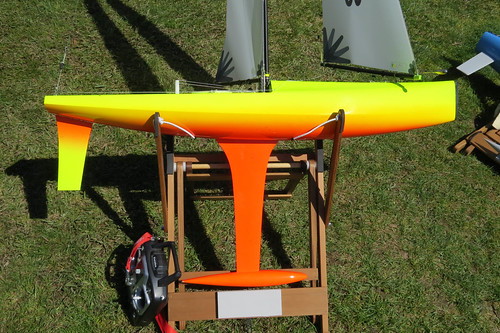Hi Dick
I resume the nArrow design models:
nArrow 1 = narrow beam, rounded shadows, PC 0.54, flush transom, 300 mm draft including bulb, DSPL 1009g, bulb 609, ratio 60%
from nArrow 1 to nArrow 3 increased Prismatic coefficient and deeper transom
nArrow 3 = narrow beam, rounded shadows, PC 0.57, deeper transom, 300 mm draft including bulb, DSPL 1083g , bulb 675g, ratio 62%
nArrow 5 = same as nArrow 3 , but with narrower deck
Why this change from 1 to 3 and 5 ?
A deeper transom produce an artificial elongation of the Water line and thus adding a potential higher speed capacity !
As you can see the major change is the PC and transom under water.
Because of that, the DSPL is different and the bulb weight also.
Generally my designs have a bulb that has ratio of minimum 60%.
Now, if you wish to use a shorter Fin and a smaller Bulb, you will loose lateral stability. This loss can be partially recovered with a shorter mast that induce a lower CE position.
Hi Tom
I’m surprised by the fin shape of the picture. Hydro-dynamically is not the best choice, would be better to have a narrow top and wider bottom if mechanically acceptable to conserve also the aspect ratio for better efficiency.
Why ? When the boat is heeling the top of the fin may protrude above the water level and generate disturbing drags at the Water-Air interface causing loss of speed !
A trick is the one used on Class M where the widest part of the fin is positioned some 10-12cm below the water level.
This solution allow to get the Fin area required without going too deep while keeping an anti-drift effect.
BTW, as “rule of thumb” the FIN area+ Rudder area should be in the range 5.5% to 6.5% of Sail Area where the rudder is 1/3 of Fin area. For faster boat it is suggested to stay on the lower % range. Catamarans, being very fast, they can go below 4% of SA for Fin + Rudder area
Cheers



